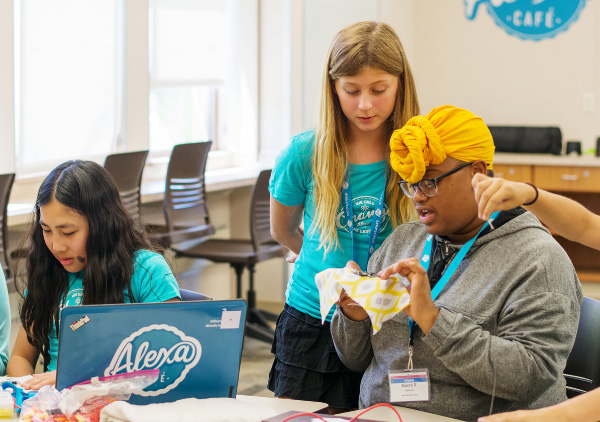Research Standards and Efficacy
The Urgency of Maker Education
The urgency behind building technological literacy and digital scientists has never been greater.
According to the United States Department of Commerce (2011), while jobs overall are expected to grow by just under 10 percent by 2018, STEM jobs are predicted to grow by 17 percent—fueling the concern that the United States will have serious and damaging shortage of STEM workers to fill open positions. Furthermore, according to a 2014 Gallup study, opportunities for students to learn computer science in schools are lacking—three in four principals surveyed report that their school does not offer computer science classes with programming/coding. Finally, SparkFun is committed to closing the STEM gap for girls and other underrepresented groups— “women still represent only 25% of the STEM workforce. This disparity is due in part to women’s comparatively low participation rates in certain STEM degree programs” (The White House Council on Women and Girls, 2012).

Research Review: Maker Education
Although an emerging branch of STEM education, researchers are starting to look into the possibilities and results of integrating maker education in the classroom. From better defining what maker education is, to looking at how it is implemented and how it impacts student achievement, researchers are beginning to build a case for maker education.
Maker Pedagogy and Science Teacher Education
Bullock, S.M. & Sator, A.J. (2015). Maker Pedagogy and Science Teacher Education. Journal of the Canadian Association for Curriculum Studies. 13(1), pp 60-87. The article discusses the concept of maker pedagogy that is drawn from the principles of the maker movement and facilitates teacher candidates in getting engaged in a curriculum for science, technology, engineering and mathematics (STEM) teacher education with students. Topics discussed include the characteristics of the maker movement, such as the use of Do-It-Yourself (DIY) culture, and introducing a curriculum for STEM teacher education.
Although few people would argue that there is some link between the disciplines of science and technology, science seems to have won a continuing place in contemporary schools, whereas technology has not fared as well.
Engineering in the K-12 STEM standards of the 50 U.S. states: An analysis of presence and extent. Journal of Engineering Education
Carr, R. L., Bennett, L. D., & Strobel, J. (2012). Engineering in the K-12 STEM standards of the 50 U.S. states: An analysis of presence and extent. Journal of Engineering Education, 101(3), 539–564. Federal initiatives promoting STEM education to bridge the achievement gap and maintain the nation's creative leadership inspired this study investigating engineering content in elementary education standards. The literature review concluded that common national P-12 engineering education standards are beneficial, particularly when amplified by the common core standards movement.Compilation and analysis of engineering present in states' academic standards was performed to determine if a consensus on the big ideas of engineering already exists and to organize and present those big ideas so that they can be infused into state or national standards.
Engineering as an iterative process that utilizes math tools and scientific knowledge to solve problems is reflected in various degrees throughout existing standards documents.
The Maker Movement in Education
Halverson, E.R. & Sheridan, K. (2014). The Maker Movement in Education. Harvard Educational Review. (84)4, pp. 495-504. In this essay, Erica Halverson and Kimberly Sheridan provide the context for research on the maker movement as they consider the emerging role of making in education. The authors describe the theoretical roots of the movement and draw connections to related research on formal and informal education. They present points of tension between making and formal education practices as they come into contact with one another, exploring whether the newness attributed to the maker movement is really all that new and reflecting on its potential pedagogical impacts on teaching and learning.
Learning through making reaches across the divide between formal and informal learning, pushing us to think more expansively about where and how learning happens.
The Promise of the Maker Movement for Education
Martin, L. (2015). The Promise of the Maker Movement for Education. Journal of Pre-College Engineering Education Research (J-PEER). 5(1), pp. 29-39. The Maker Movement is a community of hobbyists, tinkerers, engineers, hackers, and artists who creatively design and build projects for both playful and useful ends. There is growing interest among educators in bringing making into K-12 education to enhance opportunities to engage in the practices of engineering, specifically, and STEM more broadly. This article describes three elements of the Maker Movement, and associated research needs, necessary to understand its promise for education: 1) digital tools, including rapid prototyping tools and low-cost microcontroller platforms, that characterize many making projects; 2) community infrastructure, including online resources and in-person spaces and events; and 3) the maker mindset, aesthetic principles, and habits of mind that are commonplace within the community. It further outlines how the practices of making align with research on beneficial learning environments.
...bringing making into school settings has the potential to bring the creative, playful, engineering- and design-relevant learning activities of making to a wider and more diverse audience than ever before.
The Maker Movement Connects to the Classroom
Thompson, G. (2014). The Maker Movement Connects to the Classroom. T.H.E. Journal. 80(3). pp 34-37. This article discusses how to integrate Science, Technology, Engineering and Math (STEM) education with the maker movement. Topics addressed include the connections between project-based learning and standardized testing, trends in the embracing of maker spaces in higher education, and examples of maker clubs at the secondary level.
As maker projects get more time and space in classrooms, they are also gaining acceptance as proof of learning among elite universities.